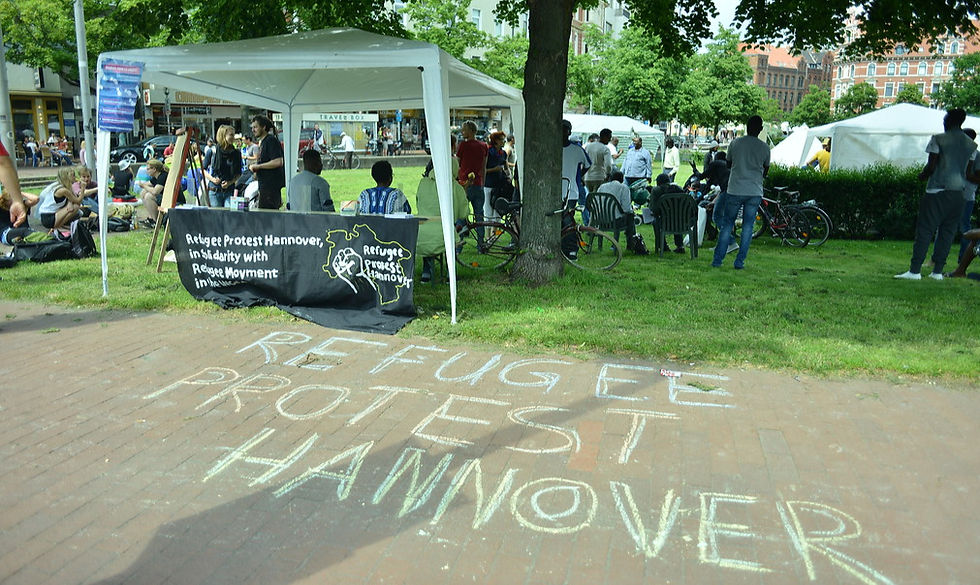
Protest Camp at
Weißekreuzplatz, Hannover
In late May 2014, approximately 40–50 Sudanese refugees and around 20 supporters established a protest encampment on Weißekreuzplatz, a small central green square in Hannover’s Oststadt district. Their aim was to challenge systemic abuses within the asylum system: forced residence restrictions, bans on work, impersonal housing camps, prolonged insecurity, and lack of legal dignity.
The camp consisted of up to eight tents: sleeping igloos, communal cooking tents, and a public infopoint near the street. Activists distributed flyers bearing messages like “We are refugees—but first of all, we are all human” and held daily conversations with passersby, building visibility for their demands.
They anchored their claim in Article 23 of the German Residence Act, which enables Lower Saxony to grant humanitarian or political group-based residence permits. Their demands included:
-
Recognition as refugees and granting of residence permits under §23
-
Abolition of residence obligation and camp isolation
-
Access to work, education, and legal support from day one
-
Humane treatment and equal rights in procedures
-
An end to deportations

The protesters engaged directly with local and state officials. A public symposium on July 31, 2014, organized with Amnesty International and the city’s Bezirksbürgermeister, saw discussions with representatives like Belit Onay and Doris Schröder‑Köpf. They detailed how Article 23 could be applied to solve their predicament.
Supporters and civil-society groups organized multiple public actions:
-
A major demonstration on September 20, 2014, under the slogan “Our Right. Here and Now”.
-
A protest march on December 6, 2014 under the banner “talk is cheap,” demanding implementation of earlier dialogues.
-
Organizations like Frieden Hannover and the Niedersachsen Refugee Council coordinated media outreach, solidarity events, and political lobbying.
After nearly two years, the camp was forcibly dismantled on April 26–27, 2016. Police removed tents during a night when most occupants were in meetings. Later, activists blocking the site were handled with force: sit-ins were broken up, tear gas used, and several people hospitalized. Public response was polarized: some residents welcomed the clearance, others—including Green party councillors—defended the camp as a high expression of democratic protest.

Although the tents have long since been removed and the square has returned to its daily rhythm, the legacy of the protest camp at Weißekreuzplatz endures with quiet strength and profound meaning.
What made this movement extraordinary was its self-organization by refugees themselves—not by NGOs, not by political parties, but by the very people most affected by exclusion and displacement. It was a rare and powerful example of agency from below, of those often spoken about finally speaking for themselves.
By bringing their struggle directly into the heart of the city, the protesters forced the public and political spheres to confront the realities of the asylum system—its isolation, legal limbo, and human cost. Their presence gave a human face to abstract policies and redefined public space as a site of human rights advocacy.
The camp played a critical role in shaping the political discourse around group asylum rights under §23 of the German Residence Act, encouraging dialogue about broader structural reforms and humanitarian residency options at the state level.
Today, the Weißekreuzplatz protest is remembered as a milestone in refugee activism in Germany—a symbol of dignity claimed, injustice challenged, and solidarity made visible. Its impact continues to echo in the work of migrant-led movements, grassroots alliances, and policy debates across Lower Saxony and beyond.



